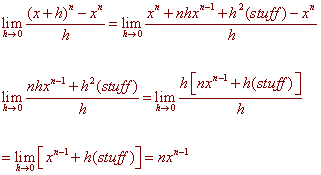Differentiation Rules
Constant Rule and Power Rule
We have seen the following derivatives:
-
If f(x) = c, then f '(x) = 0
-
If f(x) = x, then f '(x) = 1
-
If f(x) = x2, then f '(x) = 2x
-
If f(x) = x3, then f '(x) = 3x2
-
If f(x) = x4, then f '(x) = 4x3
This leads us the guess the following theorem.
|
d/dx (xn) = nxn-1 |
Proof:
First note that the binomial theorem says that
(x + h)n = xn + nhxn-1 + nC2h2xn-2 + ... + nhn-1x + hn
= xn + nhxn-1 + h2(Stuff)
For our purposes, stuff is some polynomial in h and k that we do not care about.
We have

Sum Difference and Constant Multiple Rules
Theorem: If f and g are differentiable then
A) [f + g]' = f ' + g'
B) [f - g]' = f ' - g'
C) [cf]' = c(f ')
Proof of C)
cf(x + h) - cf(x)
lim
h ->0
h
c[f(x + h) - f(x)]
=
lim
h ->0
h
f(x + h) - f(x)
= c
lim
h ->0
h
= c f '(x)
Example
We know that if f(x) = x2 then f '(x) = 2x and that if f(x) = x then f '(x) = 1 so that if
h(x) = 4x2 -3x
then
h'(x) = 4(2x) - 3(1) = 8x - 1
More Applications
Example
Find the derivatives of the following functions:
-
f(x) = 4x3 -2x100
-
f(x) = 3x5 + 4x8 - x + 2
-
f(x) = (x3 - 2)2
-
f(x) = 10

-
f(x) = 6 / x3
Solution
We use our new derivative rules to find
-
12x2 - 200x99
-
15x3+32x7-1
-
First we FOIL to get
[x6 - 4x3 + 4]'
Now use the derivative rule for powers
6x5 - 12x2
-
Begin by writing the square root sign as a fractional exponent
10x1/2
Now use the power rule to get
f '(x) = 10(1/2)x -1/2 = 5x -1/2
Example:
Find the equation to the tangent line to
y = 3x3
- x + 4
at the point (1,6)
Solution:
y' = 9x2
- 1
at x = 1 this is 8.
Using the point-slope equation for the line gives
y - 6 = 8(x -
1)
or
y = 8x - 2
Example:
Find the points where the tangent line to
y = x3
- 3x2 - 24x + 3
is horizontal.
Solution:
We find
y' = 3x2
- 6x - 24
The tangent line will be horizontal when its slope is zero, that is, the
derivative is zero. Setting the derivative equal to zero gives:
3x2
- 6x - 24 = 0
or
x2 -
2x - 8 = 0
or
(x - 4)(x + 2)
= 0
so that
x = 4 or x = -2
Back to the calculus home page